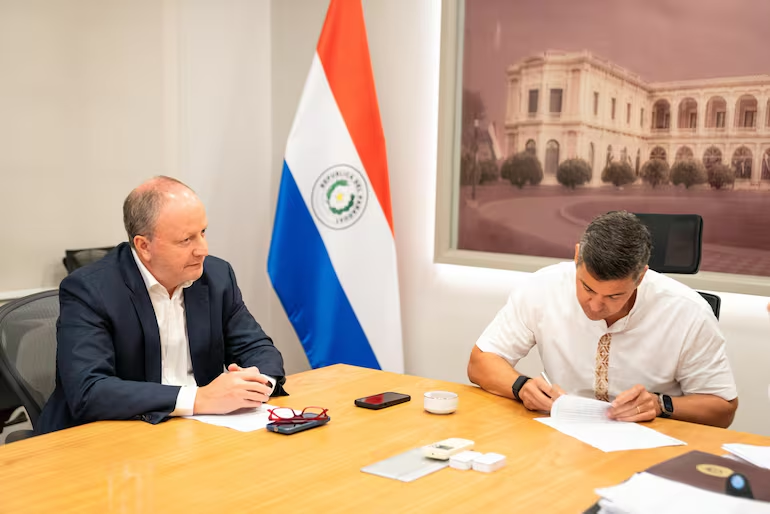On February 4, 2025, Paraguay’s government officially implemented its 2025 General Budget Plan (PGN) through Decree No. 3310, signaling a renewed commitment to fiscal transparency and efficient public spending. This financial plan serves as a roadmap for the country’s income and expenditure, aiming to streamline procurement, project execution, and overall budget management for the current fiscal year.
The plan outlines how $17.6 billion USD will be allocated, with a strong emphasis on improving public services, infrastructure, and municipal programs. Let’s break down what this new plan means for Paraguay and its economy.
What’s in the 2025 Budget?
The General Budget Plan for 2025 is ambitious, reflecting a 14.2% increase in expenditures compared to the previous year. The plan forecasts $5.28 billion USD in tax revenues and allows for a 1.9% fiscal deficit, which will be financed through the issuance of $714.5 million in treasury bonds.
Here’s how the funds are distributed:
- Central Administration: $9.16 billion
- Decentralized Entities: $8.43 billion
One key feature is the allocation of significant resources to local governments, ensuring they have the funds needed for regional development. Over $187.6 million USD from Itaipú and Yacyretá royalties will be distributed to municipalities, supporting infrastructure, education, and public services.
Addressing Fiscal Challenges
Despite its ambitious scope, the 2025 plan comes with some challenges. Paraguay’s government has acknowledged the need for flexibility and has built safeguards into the plan to adjust monthly income and spending based on resource availability. While the core budget remains intact, expenditures funded by public credit (loans, bonds) will be released based on the country’s fiscal capacity at any given time.
The Ministry of Economy and Finance (MEF) also stressed the importance of continuous monitoring to ensure the sustainability and balance of the budget throughout the year. This approach allows for real-time adjustments, helping the government respond to unforeseen economic changes.
Focus on Transparency and Modernization
One of the most promising aspects of Paraguay’s financial plan is its commitment to transparency and modernizationin public finance management. The 2025 budget introduces measures to enhance:
- Public procurement efficiency through the Annual Procurement Program (PAC)
- Clear allocation of funds for specific projects
- Stronger oversight and fiscal discipline
These efforts aim to build public trust and improve how government resources are managed. The focus on transparency also aligns with Paraguay’s broader development goals, ensuring that every dollar spent contributes to the country’s growth and modernization.
What Does This Mean for Paraguay’s Future?
The 2025 Financial Plan represents an important step in Paraguay’s journey toward fiscal stability and economic growth. With significant investments in infrastructure, public services, and local government projects, the plan is designed to support the country’s long-term development.
For investors and stakeholders, this plan signals an opportunity to engage with a country that is steadily improving its fiscal management and governance practices. As Paraguay continues to prioritize transparency and efficient use of resources, it strengthens its position as an emerging player in the Latin American economy.
In summary, Paraguay’s 2025 budget isn’t just about numbers—it’s about creating a sustainable future, balancing growth with fiscal responsibility. If managed effectively, it could serve as a model for other countries in the region striving to modernize their public finance systems.
Q1: What are the main objectives of Paraguay’s 2025 Financial Plan?
A1: The key objectives of Paraguay’s 2025 Financial Plan include promoting fiscal sustainability, improving tax collection efficiency, investing in infrastructure development, and supporting social programs aimed at reducing poverty and boosting economic growth.
Q2: How does the 2025 Financial Plan address fiscal deficits?
A2: The plan focuses on reducing fiscal deficits by implementing stricter budget controls, increasing public sector transparency, and adopting reforms to broaden the tax base. It also includes measures to curb unnecessary expenditures while prioritizing strategic investments.
Q3: What role does infrastructure play in Paraguay’s new financial strategy?
A3: Infrastructure development is a central pillar of the financial plan. The government aims to invest in transportation, energy, and digital connectivity to enhance economic competitiveness and attract foreign investment, especially in underdeveloped regions.
Q4: How will the 2025 Financial Plan impact foreign investors?
A4: The plan seeks to create a more attractive business environment by simplifying regulatory processes and offering tax incentives in key sectors such as agriculture, manufacturing, and renewable energy. These measures are designed to boost investor confidence and foster long-term economic partnerships.






Leave a Reply